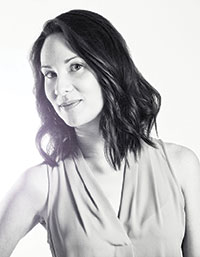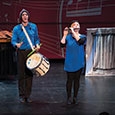These four highly creative and entrepreneurial flutists have carved unusual career paths. They perform in innovative ensembles that explore new ways to connect with audiences and integrate a variety of artistic styles and sounds.
What sets your ensemble apart from other groups and what is your role in the group?
Hilary Abigana: My trio, The Fourth Wall, is a hybrid arts ensemble in which musicians are also dancers and actors. Essentially, we are musicians who dance while playing our instruments. Imagine Astor Piazzolla’s Histoire du tango in which the dancers are providing their own music. Our performances are a mix of commissioned music by living composers and reimagined favorites ranging from Bach to The Beatles. The choreography is as wide ranging as the music: from classical ballet (I dance en pointe) to modern dance to vaudeville circus tricks. Along with performing across North America, we teach workshops and masterclasses at universities, high schools, and instrument associations (like NFA). We believe that there is so much to learn from the other performing arts and encourage students to try their hand at the theatrical and physically active.
Valerie Coleman: I am the founder and flutist of a touring woodwind quintet called Imani Winds. The ensemble is comprised of flute, oboe, clarinet, bassoon and horn.
We play concerts throughout the US at colleges, universities and for flute (and other instruments) societies. The music that we play ranges from standard works for wind quintet to original works from my own pen. We also commission composers to create new works for us. The works that I write for the group always have an element of different cultures from around the world. For example, UMOJA celebrates the African diaspora holiday of Kwanzaa, Tzigane is in the tradition of Balkan music, and the Afro-Cuban Concerto celebrates the special rhythms of Cuba.
Zara Lawler: I have a duo with percussionist Paul J. Fadoul. Together, we are Lawler + Fadoul, and we do inventive theatrical chamber music, traditional classical recitals, and engaging programming for children. Last year, we debuted a new program, an interactive theatrical concert called Clickable: The Art of Persuasion which we created with stage director Rachel Peake. It includes a lullaby, a protest song, custom commercial jingles, a spoken word piece written for us by Liza Jessie Peterson, three settings of dust jacket texts, and a serenade by Katherine Hoover. This year, we are recording Clickable as our second CD. Last fall, we also spent a week playing concerts in elementary schools in western Massachusetts under the auspices of a grant from Chamber Music America.
Melissa Snoza: I am the founding flutist and executive director for Fifth House Ensemble, a large mixed instrumentation chamber group based in Chicago. Fifth House Ensemble taps the collaborative spirit of chamber music to create engaging performances and interactive educational programs, forging partnerships with unexpected venues, artists of other disciplines, educational institutions, and audiences of every type. As the ensemble’s flutist, I rehearse, perform, teach, speak, and design programs along with the rest of our artists. In addition to our composer and Artistic Director, Dan Visconti, the group’s full instrumentation includes flute, oboe, clarinet, bassoon, horn, violin, viola, cello, bass, and piano. As executive director I make sure that our programs align with our mission, am the liaison to the board, lead our financial management and development efforts along with bookkeeping and grant writing staff, and am the primary driver of our higher education entrepreneurship programs.
What led you to this performance style?
Abigana: Each member of our trio found our path to the hybrid arts in different ways. There is a breadth of literature for speaking percussionist that has been around for decades which is how our percussionist, Greg Jukes, came to this. Our bass trombonist, C. Neil Parsons, grew up in a theater family, but chose to attend music school. There he took a dance class and remembered how much he missed the freedom of physical self-expression. I took numerous dance classes as a child and young adult, but it was Oliver Knussen’s Masks that ignited my desire to move while playing my instrument. Knussen gives the performer simple stage directions (begin off stage, turn up and down stage, etc.) which I took and ran with. I now perform the piece in costume and in pointe shoes. The three of us met through a different company that did similar work. When we left that group to form The Fourth Wall, we changed our focus from solely young audience programming to general audiences and from story-based works to a plethora of styles.
Coleman: The opportunity was created through daydreaming. I had just moved to New York City to begin graduate studies with Judy Mendenhall at Mannes College of Music. I remember sitting on my bed in a tiny sublet room, dreaming about how I could make a difference in the world around me through my craft when the name and concept of Imani Winds popped into my head. The name came before the actual ensemble, and that gave me the courage to start my own group. I began to look for other like-minded musicians from Mannes, Manhattan School and Juilliard and found them, one by one. They each received a cold solicitation phone call from me (because not everyone had an email address in 1997) and somehow I convinced them each to meet and read through music one spring day in a practice room at Manhattan School of Music. The group was born.
Lawler: Paul and I met when we both played in Tales & Scales, a group that did innovative children’s performances. Almost immediately, we started playing duo concerts on the side, and we really loved playing and working together. Since I left T&S in 2008, we have focused much more on our duo.
Snoza: Fifth House formed after many of its founding players participated in the Civic Orchestra of Chicago’s MusiCorps program in 2005. When I helped to program a concert at Indian Boundary Park through Civic, I realized that it was the first time I had performed for an audience that was not made up of adjudicators or peers – in other words, people who were either judging me for a grade or there to decide whether or not to give me a job. The audience reaction was an eye-opening experience. They picked up on things I would not have thought to emphasize (a Chicago firefighter connected to our ability to communicate with our eyes and gestures because he and his team work the same way when running into a burning building) and also let us know that we had made their day better. I realized that music is a gift given with both hands open; that while my experience of studying up to that point had been largely about my own personal achievement, it was now about giving the audience the best possible experience. This changed why I do what I do, and was a large part of the reason we formed Fifth House.
What is your programming philosophy?
Abigana: Our programming is quite eclectic. The show we tour with most often is called Fruit Flies Like a Banana, a madcap variety hour in which we attempt to perform over 20 pieces in 60 minutes (with a timer ticking down), but the audience determines the show order. The fast-paced nature keeps us on our toes and in the moment which is infectious to the audience. The pieces range from Trepak from The Nutcracker to Milonguella by Miguel Bareilles to Piano Man by Billy Joel (though we call it Toy Piano Man and play it on toy piano, slide whistle, and melodica). We find that the eclectic programming is entertaining to musicians and non-musicians alike. Non-musicians enjoy hearing the classical favorites, while musicians enjoy hearing them done in a very atypical way (Eine Kleine Nachtmusik on tuned plastic tubes called Boomwhackers for example). There are moments of full audience participation, laughter, and learning (as we explain the instruments, composers, and history), all the while poking fun at each other and having a great time.
We also have longer works such as Vassal of the Sun with music commissioned from Stefanie Lubkowski, inspired by Moby Dick and utilizing a circus prop we designed and commissioned from Phil Servita. The prop, which we refer to as the Hamster Wheel, is a combination of a German Wheel and a Cyr Wheel that can break down into four A-frame curved pieces that evoke the movement of boats and waves. Much more serious than Fruit Flies Like a Banana, Vassal is an evening-length piece that evokes the poetic and epic nature of Melville’s classic.
When we are creating a piece, we frequently start by saying to each other “Do you know what’s a terrible idea?” and then we try it. Usually that terrible idea is tweaked into something wonderfully grand. So perhaps our programming philosophy can be distilled down to: How can we get as many formerly terrible ideas into one show as possible?
Coleman: We strive to bring to depth to wind chamber music that is inclusive of cultures, genres and underrepresented composers. At the same time we want to offer a fresh interpretation of Classical music at the highest quality in a way that connects to audiences.
Lawler: Our first CD, Prelude Cocktail, was four centuries of preludes (with a few fugues thrown in for good measure). Most of the pieces were transcriptions of keyboard solos, and we commissioned two new sets of preludes from Katherine Hoover and Roshanne Etezady. When choosing pieces to transcribe, our criteria were very clear: the piece had to work for our instrumentation, and we both had to love it. Though there was a little conflict during the decision-making process, it worked out beautifully, and we ended up with 80 minutes of music that we both love. For Clickable, the process was a little bit more amorphous because we were trying to create a new kind of concert, not just a new repertoire list. We worked with a theater director to put it all together, and we focused on the idea of persuasion in music and words. Before we chose any music, we had to ask ourselves what kinds of music and words are persuasive. We came up with lullabies (please go to sleep), commercial jingles (please buy this), dust jacket texts (please read this), protest songs (please don’t do that), and serenades (please love me). Then we researched and listened to tons of each kind of persuasive music, and eventually found ones that would, like our preludes, work for our instruments, work for the concept of the show, and that we loved.
For both projects we commissioned several pieces, and that is always so exciting. It is different, though, because you do not know ahead of time if you will love the work. To find our composers (and our poet – one commission for Clickable was for a spoken word piece), we both brought people to the table who seemed like good candidates. These were people we had both worked with before so we knew that they would be good collaborators and that we liked their previous work.
Snoza: Our programming process is collaborative as well. Ideas can come from anyone in the ensemble to start things off, and our Artistic Director, Dan Visconti, works with a team of musicians on each project to bring it to life. Fifth House is always interested in pushing beyond the perceived limits of classical music. Our programs began with collaborations with artists outside of our discipline (graphic novelists, video game designers, dancers, actors), and we now work with partners completely outside of the arts to build new works (astronomers, workers’ rights organizations, the ACLU, agricultural communities, etc.). The spectrum of what we do includes concerts we create (either by ourselves or with artistic partners) for audiences that are complete when they hit the stage, like Journey LIVE, as well as social and civic practice projects where we work with communities and non-arts partners to engage on social issues, like Voices from the Dust Bowl or Degenerate Art. (For more on audience-centric programming, the first video in this series is helpful: https://youtu.be/6LotPhGzYwU)
Where do you usually perform?
Abigana: We have found a home in the world of fringe theatre festivals. They are held all over the world and are comprised of typically non-juried, uncensored shows that have fringe or out-of-the-box programming. Our madcap variety hour, Fruit Flies Like a Banana, fits right in with the weird, eclectic nature of these festivals and because we are typically one of only a small handful of music-based shows, we stand out well. It is customary for the artists to pass out flyers to potential patrons, talk to them about the show, and encourage them to come see it. It is an insane amount of hard work and pavement pounding for ten glorious days, but it pays off. Along with fringe festivals, the flute community has been incredibly good to us, and we have visited many universities and colleges across the country to work with music students. When we produce our own show somewhere, we write press releases, submit the event to online calendars, talk to friends in the area, and make posters and flyers. It generally involves quite a bit of trial and error.
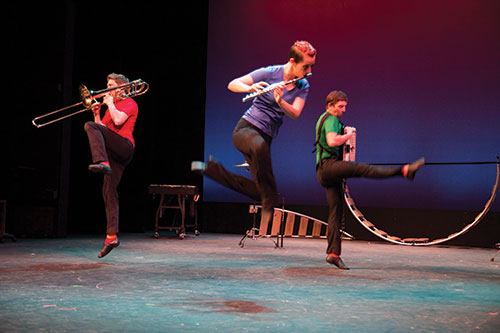
The Fourth Wall performing Fruit Flies Like a Banana
Coleman: Since our ensemble is more of a traditional chamber music group, our goal was to build a following, starting in New York City. Initially, we created and produced our own concerts through local churches and schools. This gave us the opportunity to build a substantial amount of repertoire. From there, we participated in competitions and happened to win one that gave us our first management/booking agent through Concert Artists Guild. Since then our concerts have come from bookings by concert halls and performing organizations, known as presenters.
Lawler: Our concerts happen in one of three ways. The first is that someone books us to do a recital or concert. That simple sentence is a bit deceiving though, as what that means is we have built up a relationship with a presenter (either at an independent concert hall/series or at a university), often over the course of years, that manifests itself as a concert at some point. Sometimes we initiate that process (“Hey, we’ll be in your area in fall 2018, and we’d love to bring our out-of-the-box performance style to your series.”), and sometimes they initiate it. We also produce performances ourselves. This means we rent or borrow a hall, sell tickets, and do all of the work ourselves to generate an audience. It is a lot of work, so we do it as seldom as possible, but sometimes it is the best way for us to jumpstart a new program, or play for a particular audience. Finally, many, though not all, of our educational performances come about through our relationship with the National Symphony Orchestra at the Kennedy Center. We are one of their official In-School Ensembles, so they send us to schools in the Washington, DC area several times a year. It is a great program that allows us to perform for kids every year, which is not only important to us, but is also really fun.
Snoza: We usually either self-produce (rent or do a ticket split with a venue and then keep the proceeds from the door) or are paid a fee to perform. Much of our programming is venue specific and collaborative, meaning that we might be engaging the space and its constituents as partners in creating a project through our civic practice initiatives. As an example, Instituto Cervantes was both a venue and a cultural partner in our Nedudim project, which was created in partnership with the Mediterranean folk band Baladino and included conversations about music and cultural identity with cultural organizations that represented Iran, India, Spain, and Israel.
Do you have non-profit status?
Abigana: We currently operate as a Limited Liability Partnership as three equal partners, but are beginning to take steps towards becoming a non-profit organization.
Coleman: We initially choose to form a business partnership, where each founding member had equal share. With the departure of our founding clarinetist and adding a new member, Mark Dover, we decided to turn our business into a Limited Liability Corporation. This basically means that the business is an entity unto itself, and its governing body or employees are exempt from any liabilities. For grant writing purposes, Imani Winds has a 501(c)(3) fiscal umbrella, to which we pay yearly membership dues.
.jpg)
Imani Winds
Lawler: We are not a non-profit, but I have a fiscal sponsor, The Field, an umbrella organization for the arts here in NYC. Through my fiscal sponsorship at The Field, I can solicit donations from supporters and the donations are tax-deductible for the donor. In other words, I can function sort of like a non-profit without having to have a Board of Directors and without going through the legal process of setting up my own 501(c)(3) status. It is a great option for independent artists and small groups. Through it I can fundraise like a non-profit to support the work of both Lawler + Fadoul and my solo project The Flute on its Feet. Every year I send out a fundraising appeal to my regular supporters, just like a non-profit does, and I also have built up a small group of committed major donors. In addition, we usually do a couple of fundraising concerts every year. This plus fees from performances and teaching, as well as the occasional grant, comprise my operating budget for the year, which supports commissions, recordings, travel, rehearsal space, a publicist, and so forth.
Snoza: Fifth House is a nonprofit organization. I basically sat on the floor of a bookstore and learned how to create a nonprofit, including filing with the Secretary of State to form the organization and working on the IRS process to get federal tax exemption afterwards. I also learned to form an LLC, which we did to support our private events business in the same year. This allowed us to play weddings and events to earn income while the nonprofit was getting established. Our board started with friends and family in addition to ourselves, and then grew over the course of several years to include professionals in finance, consulting, marketing, and more.
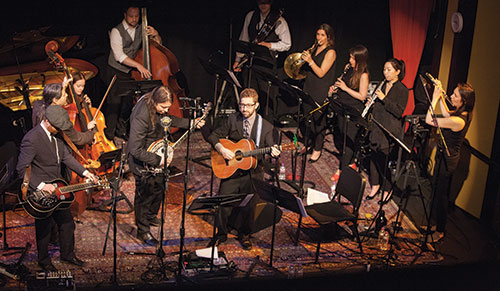
Fifth House Ensemble
How many concerts do you present a year?
Abigana: Each season since our founding in 2010 has gotten busier. We anticipate being on tour from mid-July through the end of October – visiting festivals and universities from Manitoba to Arizona. I think we gave around 100-150 performances in 2017.
Coleman: Our touring season is on average 150-200 days of the year.
Lawler: We give about 60 performances, including the in-school concerts for the National Symphony Orchestra.
Snoza: We do about 150 concerts and educational events per year.
Do you have other employment?
Abigana: Neil, our trombonist, recently finished his master’s degree at Boston Conservatory at Berklee and is now on faculty as an Instructor of Theatre there. He is also a licensed massage therapist. Our percussionist freelances in Boston, teaches online lessons, runs a non-profit company, and narrates with orchestras. I manage The Fourth Wall’s bookings and publicity and bartend at a local craft brewery. We do not view our other jobs as necessary to make ends meet, but instead see them as fulfilling aspects of our lives.
Coleman: I am currently a visiting lecturer at the University of Chicago, where my ensemble is also in residence, and a faculty member of Banff’s Summer Programs. My other full-time day job is being a composer, which is beginning to be a noticeable portion of my yearly income. As a masterclass artist and clinician, I perform solo flute/composer recitals regularly, and often introduce audiences to new works I have written.
Lawler: We both have other creative projects and teach. I have my solo project The Flute on its Feet, which combines solo flute performance with dance and theater. I also teach at Manhattan School of Music Precollege and privately. I am a Suzuki flute teacher and love working with young beginners. Paul spends his summers working with a chamber group based in Canada called Dark By Five. He just started teaching at Gettysburg College Sunderman Conservatory in Virginia, and also writes music for and leads drumlines.
Snoza: I work full time with Fifth House Ensemble but also serve on the faculty of DePaul University (arts entrepreneurship) and do some consulting work individually for artists and organizations.
* * *
Hilary Abigana
Hilary Abigana is a founding member and flutist for The Fourth Wall, a hybrid arts ensemble in which musicians are also dancers and actors. The Fourth Wall performs across North America in venues ranging from performing arts centers to elementary schools to (Le) Poisson Rouge and Off-Broadway theaters in New York. They are also a favorite at Fringe theatre festivals. Abigana co-founded the Irish Arts Academy of Indianapolis, was on faculty at Floot Fire in Texas, and serves on the Strategic Planning and Career & Artistic Develop-ment Committees for the National Flute Association. She received her Bachelor of Music with Distinction and Performer’s Certificate from The Eastman School of Music (Bonita Boyd) and her MM degree from Rice University’s Shepherd School of Music (Leone Buyse). www.hilaryabigana.com, www.thefourthwallensemble.com
.jpg)
Valerie Coleman
Valerie Coleman is a composer and flutist with Imani Winds. She founded the group and has been instrumental in its continued development. The group has appeared throughout the US in various concert venues and offers masterclasses at universities. Coleman has received commissions from the Collegiate Band Directors National Association, Chamber Music Northwest, Virginia Tech University, Virginia Common-wealth University, National Flute Associ-ation, West Michigan Flute Society, Orchestra 2001, The San Francisco Chamber Orchestra, The Brooklyn Philhar-monic, The Flute/Clarinet Duos Consortium, Hartford Symphony Orchestra, Chamber Music Northwest, Carnegie Hall, American Composers Orchestra and the Interlochen Arts Academy. Coleman received her B.M. from Boston University in both flute performance and Music Composition/Music Theory and an M.M. in flute performance from Mannes College of Music. She studied with Julius Baker, Judith Mendenhall, Alan Weiss and Kathleen Karr. www.vcoleman.com, www.imaniwinds.com
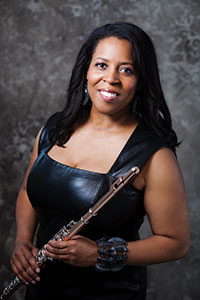
Zara Lawler
Flutist and performance artist Zara Lawler has collaborated with choreographers, composers and stage directors to create new and adventurous concert programming. Lawler + Fadoul (with percussionist Paul Fadoul) has recorded a CD Prelude Cocktail, and performed their family show Break it Down! at the Kennedy Center. Their new theatrical project Clickable, featuring music of persuasion, was incubated and premiered at nancy manocherian’s the cell theater in NYC in November 2016, and will be released as an album in 2018. Lawler directed the US premiere of Il Cerchio Tagliato dei Suoni, Salvatore Sciarrino’s work for 104 flutists at the Guggenheim Museum and a Flute Jamboree at the Kennedy Center. Lawler also performs with choreographer C. Neil Parsons. As an educator she has taught workshops on interdisciplinary performance at Indiana University Jacobs School of Music, The Eastman School of Music, Rutgers, Manhattan School of Music, and the National Flute Association’s annual conventions. Lawler is a graduate of The Juilliard School where she studied with Carol Wincenc and Samuel Baron.
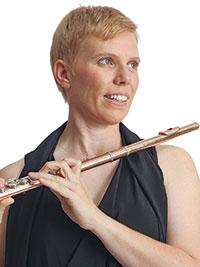
Melissa Snoza
A passionate advocate for chamber music, Melissa Snoza is a founding member of Fifth House Ensemble which is based in Chicago, Illinois. A dynamic educator and coach, Snoza currently teaches a music entrepreneurship course at DePaul University and has served as professor of flute at Carthage College. As Fifth House Ensemble’s Executive Director, she drives the organization’s entrepreneurship programs and has created workshops for New England Conservatory, the Colburn School, Indiana University, the Eastman School of Music, TEDx Michigan Ave, and the fresh inc festival on arts entrepreneurship and creative programming. Her writing has been featured on the Entrepreneur the Arts blog and Huffington Post. She played with the Wisconsin Chamber Orchestra, the Civic Orchestra of Chicago and the Peninsula Music Festival and has performed in South America, Europe, Russia, and Japan. Previous award credits include First Prize at the National Flute Association’s Orchestral Audition Competition. She is a graduate of the Eastman School of Music (Bonita Boyd) and Northwestern University (Walfrid Kujala). melissa@fifth-house.com, www.fifth-house.com
